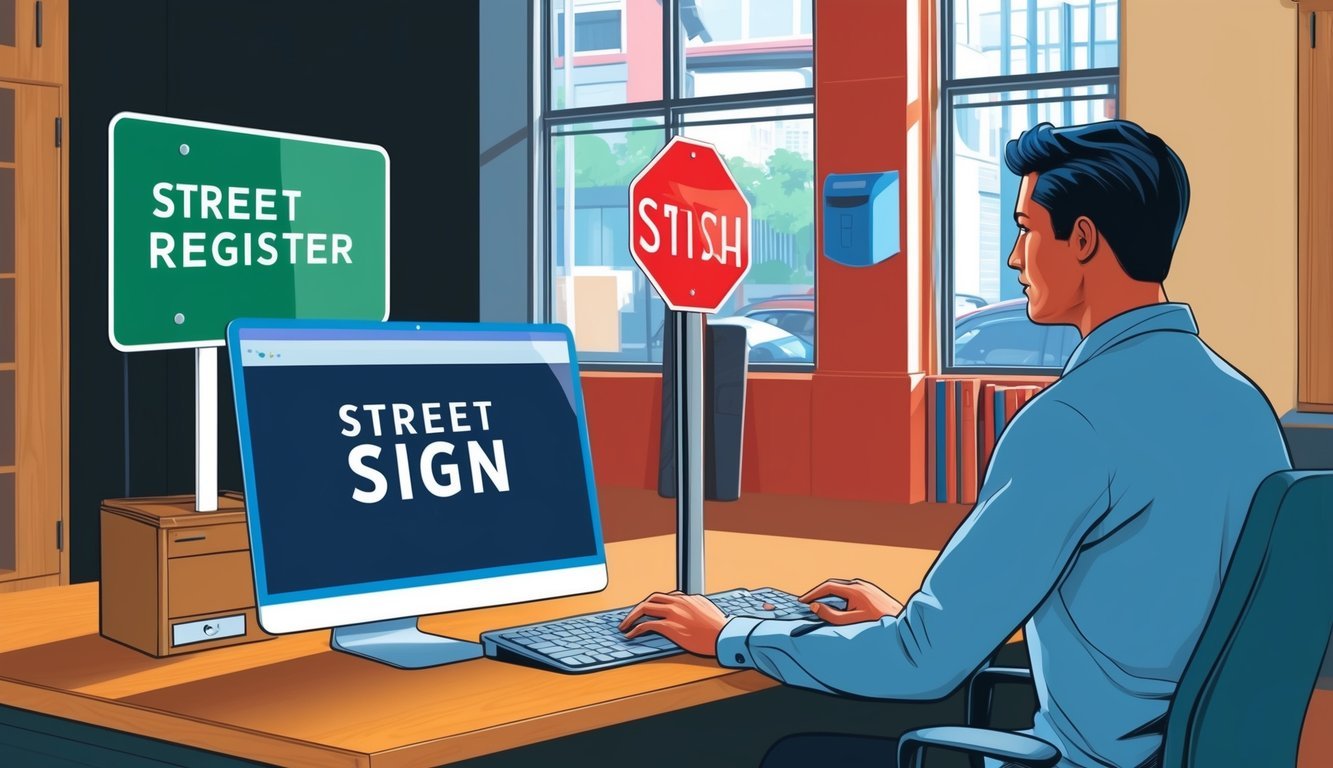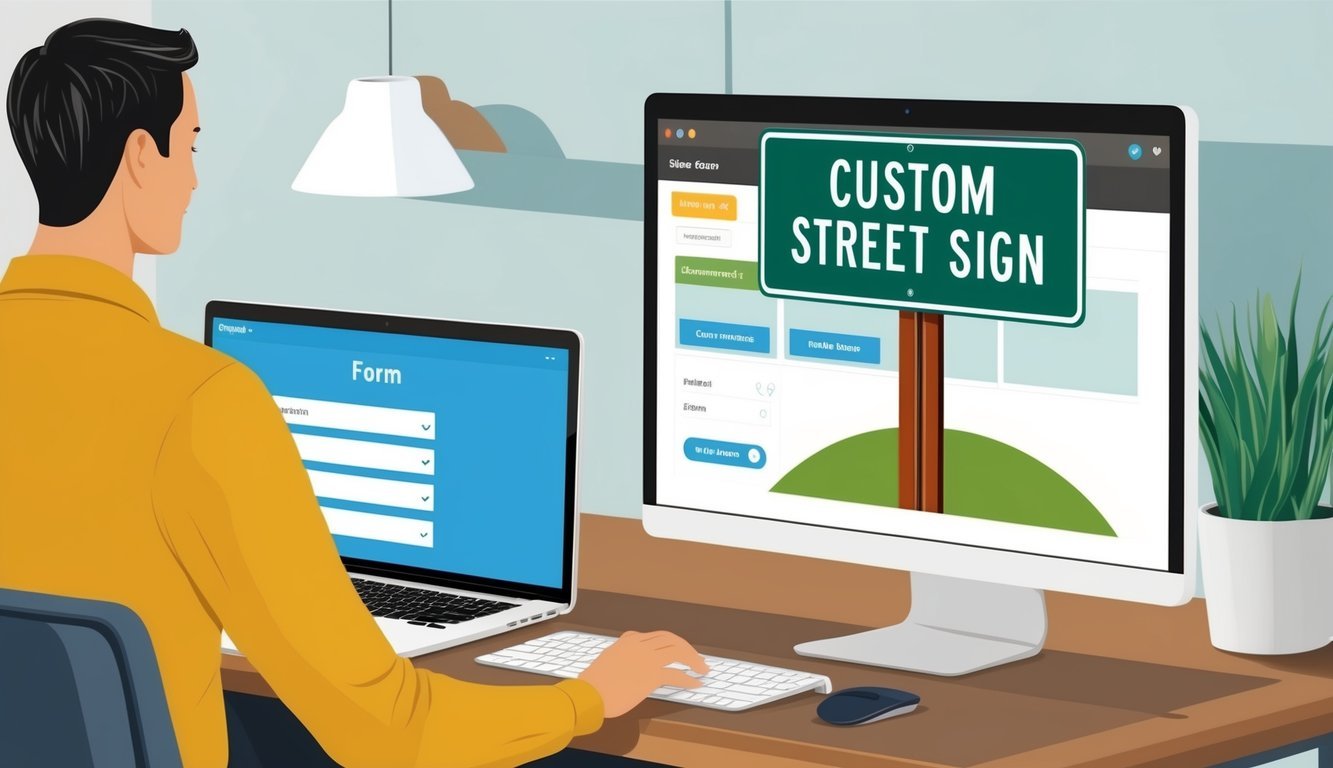Street signs are more than just symbols on a pole; they’re the friendly guides that help us navigate our way through bustling neighborhoods and cities.
Have you ever considered creating your very own custom street sign? It’s actually a lot easier than you think!

If you’re looking to sign up for a custom street sign, your best bet is to reach out to your local Department of Transportation.
You can either give them a call or hop on their website for the lowdown.
Keep in mind that each city has its unique rules and processes when it comes to requesting custom signs.
Some places even let you order commemorative signs to celebrate memorable people or events.
Just make sure to read those guidelines before you dive in; you don’t want to get a big “no” because your sign doesn’t meet local specs.
Oh, and if you’re curious about getting a no-parking sign, many cities have online forms or you might need to make a trip to your municipal office.
Don’t forget to gather details like the sign’s location and the reason for your request!
Before you jump into the design process, it’s helpful to understand the basics of street sign design.
Most cities have strict rules regarding sign size, color, and placement.
These regulations are in place to ensure that the signs remain clear and easy to read for everyone, whether you’re driving or walking.
Key Takeaways
- Start by contacting your local Department of Transportation.
- Remember, different cities have distinct rules for custom street signs.
- Grasping basic design guidelines can speed up the approval process.
Getting Started with Street Sign Registration

Registering for a street sign is about understanding the rules and picking the right materials.
It’s like constructing a solid foundation for your sign to ensure it meets safety standards and local demands.
Understanding the Basics of Street Signs
Street signs are essential for traffic safety; they guide both drivers and pedestrians along local roads.
The Manual on Uniform Traffic Control Devices (MUTCD) outlines the rules for traffic signs across the US.
In case you didn’t know, MUTCD-compliant signs have specific colors, shapes, and sizes.
For example, always watch out for those red octagon stop signs and the white speed limit signs featuring black numbers.
Street name signs typically have a green background with white letters, but some areas switch it up for historic districts.
For safety, signs need to be visible day or night, placed at just the right height and angle for easy reading.
Selection of Street Sign Materials
Choosing the right materials for your street sign is pretty crucial.
You want something that’ll last through rain and shine, right?
Aluminum is a popular pick.
It’s lightweight, sturdy, and doesn’t rust.
Many signs are topped off with reflective sheeting to make them shine in the dark.
Plastic signs are easier on the wallet but don’t hold up as well.
They’re a good fit for temporary signs or less-traveled areas.
If you’re thinking about street name signs, double-sided designs are a clever touch.
This way, folks can read them coming from both directions.
Plus, some places opt for breakaway posts to enhance safety in case of accidents.
Keep in mind that the materials you choose affect not just the sign’s longevity but also how well it reflects light.
Sure, high-quality materials might cost more upfront, but they often save you money in the long run.
Design and Customization

Creating your own street sign opens up a world of possibilities! You can mix and match colors, design elements, and materials to make something uniquely yours.
Creating Your Custom Street Sign
There are lots of flavors when it comes to custom street signs.
You can go for flat blade designs or choose three-dimensional styles that really pop.
Play around with eye-catching background colors! Add your street name, house number, or even a quirky saying that reflects your personality.
Some people love crafting novelty street signs with jokes or playful names.
Others prefer a more classic look that fits snugly within their neighborhood’s vibe.
Want to add some flair? Feel free to sprinkle in borders or graphics!
There are plenty of online tools that make designing your sign a breeze.
You can drag and drop text and images until it looks just right for you.
Whether you want to start fresh or choose a template, the options are yours.
Choosing Reflective Materials for Visibility
Reflective materials are key to making your sign easily visible at night.
Think of it like a superhero’s cape—it needs to shine bright when headlights hit it, right?
High-intensity prismatic and diamond-grade reflectives are top-notch, especially for low-light areas.
For most home signs, regular reflective vinyl does a solid job without breaking the bank.
Reflective aluminum is durable too.
It’ll stand up to the elements for years without rusting or degrading.
Great for signs that need to remain steady through the seasons.
Understanding Sign Size and Post Options
Street name signs aren’t one-size-fits-all.
Widths can range from 6 inches for smaller roads to up to 12 inches for busy streets.
The length can also change depending on how long the name is—longer names need bigger signs.
For posts, U-channel posts are strong and simple to install.
If you’re after aesthetics, square posts offer a more polished look, and fancy posts can even help your sign match your home’s style!
Just be sure the sign is high enough to be seen without overwhelming the landscape.
Most home signs sit around 7 feet tall, striking that perfect balance between visibility and practicality.
Frequently Asked Questions
You can usually order custom street signs online or in person.
It involves picking materials, colors, and text.
But remember, costs and lead times vary based on how intricate your design is.
What’s the process for creating a custom street sign online?
It’s pretty straightforward! You select a sign style, input your text, and choose your colors.
A preview might be available before you complete your order, and all you need are payment and shipping details.
Can I get a personalized metal street sign, and how?
Absolutely! You can personalize metal street signs, with many sign makers offering options in aluminum or steel.
Just pick your size, color, and text.
Some places even allow you to upload your own designs or logos.
What’s the typical turnaround time for a custom-made street sign?
Most custom signs take about 1-3 weeks to produce, though rush orders are sometimes possible for quicker delivery.
If your design is super complex or if you’re ordering in bulk, it might take a bit longer.
Looking for a street sign generator, any good ones out there?
There are definitely some solid street sign generators online.
These handy tools let you whip up mock-ups of your signs.
Some are free, while others might charge for high-resolution images or printing services.
Where can I find a maker for custom street signs near my location?
Your best bet is to look for local sign shops—they’re often your go-to for custom street signs.
Try searching for “custom signs” along with your city name, and don’t forget to check reviews to find reputable options.
Sometimes, home improvement stores also have this service available.
Why might custom street signs come with a hefty price tag?
Great question! Custom signs often use quality materials to resist the elements, and the labor involved in design and production adds on to the total cost.
You’ll find that small-batch manufacturing is pricier than mass production, especially if you’re adding special features like reflective coatings.
It might sting a little, but you’re investing in something that’ll last!

